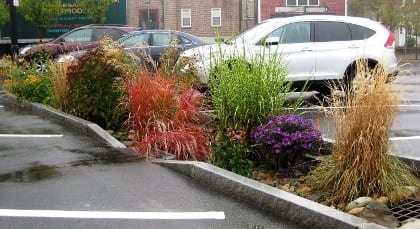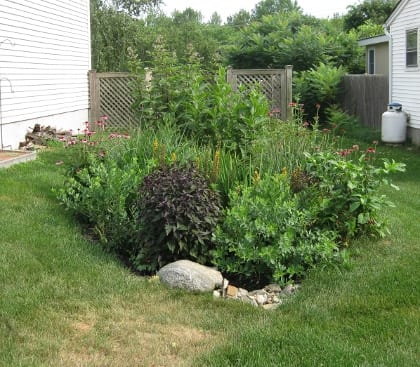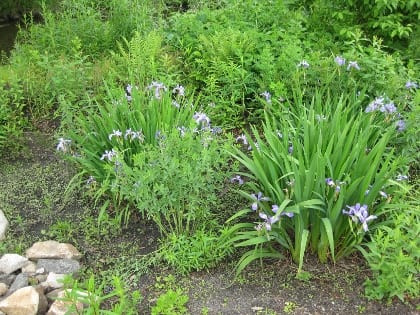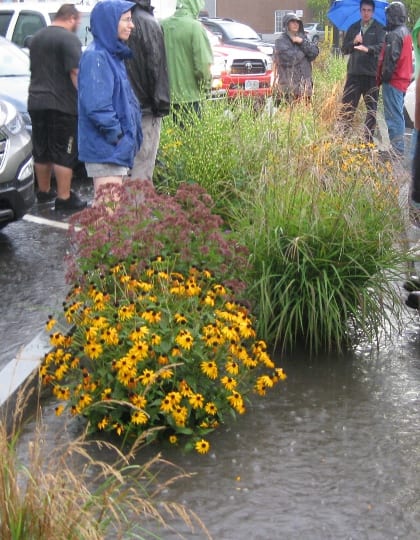by Catherine Neal
Modern storm water management systems rely on vegetation to hold the soil, filter contaminants, absorb nutrients, intercept and transpire water, and support healthy and diverse soil biology. Engineers are only beginning to appreciate the contribution that landscapers can make to help green infrastructure survive and thrive. Selecting appropriate plants for biofilters, bioswales, rain gardens and other vegetated storm water management systems is a critical first step to their success. But remember that plant selection only goes so far; though not discussed here, for long term success a maintenance plan must be implemented.
Assess the Site and Situation
As with any landscape job, plant selection should begin with a careful analysis of the site and situation. Not all biofilters, bioswales, or rain gardens are the same and may require plants that tolerate different extreme conditions. Bioswales constructed from native soils may retain water for days at a time if the underlying soils are clay or if drainage is limited by impermeable layers underneath. Newer biofiltration areas engineered for storm water management may infiltrate up to 20-30” of water per hour through a super well-drained matrix of sand, rock and loam or compost. Saturation of the root zone in these systems is brief in most cases, and plants are more likely to be challenged by drought than by prolonged wet feet.

This biofiltration area in a busy parking lot has been replanted more than once to find plants that can stand being deluged with water passing through at 20” per hour, followed by periods of extreme drought. The best survival rate was for maiden grass cultivars. Purple coneflower, Rudbeckia ‘Goldsturm’ and Helenium had poor survival rates so most have been replaced with asters and Joe Pye weed, which are holding their own.
Runoff from roads and parking lots may contain organic waste materials and volatile organic compounds (from oil and gas), as well as inorganic contaminants such as road salt, sediment, and trash. Nutrient levels may peak with the first flush but bottom out with continuous flushing through of storm water. What other challenges does the site present – deer or rodents? Invasive plants nearby? Shadows or reflected heat from buildings? Wind exposure? Foot traffic? The plants better be prepared for almost anything to come their way!
Additionally, municipalities or other entities responsible for maintenance may present some challenges. Mowing may be second nature to them, but removing sediment, weeding, pruning, and other plant maintenance tasks are unlikely to get done unless there’s a plan (and some training), or better yet, a contract with a landscape maintenance firm. And what happens during the winter? Does the rain garden become a snow dump? Then we’d better not put in trees and shrubs if we don’t want broken trunks or branches.
Layer Plantings
Deciduous trees can transpire huge amounts of water during the summer, but should only be included if there is adequate soil volume (width and depth) and room for the canopy to mature. Suitable choices are most likely to be the same species that survive the compacted, poor soils typical of many urban situations. Here in New England, Green ash (Fraxinus pennsylvanica) (before emerald ash borer), thornless honey locust (Gleditsia triacanthos inermis, which also has issues with diseases and insects) and red maple (Acer rubrum) are good examples, albeit overused. Swamp white oak (Quercus bicolor), river birch (Betula nigra), ironwood (Carpinus caroliniana), and serviceberry or shadbush (Amelanchier sp.) can stand fluctuating soil moisture, but consider size, soil pH, salt tolerance, and potential for pests (such as rust on shadbush) when making your selections.
Planting in layers is another way to increase foliage density and therefore transpiration. The shrub layer might include red or black chokeberry (Aronia arbutifolia or A. melanocarpa), buttonbush (Cephalanthus occidentalis), red-twigged or silky dogwood (Cornus amomum or C. sericea), winterberry (Ilex verticillata), witch hazel (Hamamelis virginiana), rhodora (Rhododendron canadense), and oakleaf hydrangea (Hydrangea quercifolia). Cranberry (Vaccinium macrocarpon) or lowbush blueberry (Vaccinium angustifolium) are good ground covers for acid soils, as well as many ferns and sedges. Suckering shrubs such as summersweet clethra (Clethra alnifolia) and fragrant sumac (Rhus aromatica) will fill in bare spots quickly and prevent weed completion. The listed plants are most suitable for the wetter, bottom zone of the rain garden whereas other plants that can tolerate occasional, but not constant wetness, can be used on the sides and upper edges of buffers, bioswales and rain gardens. Examples include northern bayberry (Myrica pensylvanica), sweetfern (Comptonia peregrina), and several Viburnum species.
Plant for Specific Conditions
Choose plant groups that have the same pH and soil moisture requirements. Do you have a rain garden site in partial shade with moist, acidic soils? Combine pinkshell azalea (Rhododendron vaseyi) or swamp azalea (R. viscosum) with high- or low-bush blueberry (Vaccinium corymbosum or V. angustifolium), ferns and/or sedges, and perhaps some winterberry (Ilex verticillata) for year-round interest.

This residential rain garden collects water from the rooftop as well as surrounding turf area. The lush growth reflects good moisture conditions and nutrient availability. Plants in the center (Ligularia ‘Little Rocket’ and Joe Pye weed, for example) prefer constant moist to wet soil, whereas those placed in the upper zone (such as purple coneflower) prefer drier conditions.
Small residential rain gardens will tend to look more like gardens than the engineered systems and can be densely planted with your favorite plants. These gardens should not hold water for more than 24-48 hours after a storm. There are more herbaceous perennials to choose from than I can even begin to name – just find the right spot (high or low on the bank?) for each of your favorites. Blue flag iris (Iris versicolor) is a plant that seems to be highly adapted to the lowest area of the rain garden – we have seen it survive where many other species have failed. And the great thing about cardinal flower (Lobelia cardinalis), besides its bright red color, is that it reseeds and will migrate over time to settle in its preferred location. Purple coneflower (Echinacea purpurea) and brown- or black-eyed Susans (Rudbeckia hirta or R. triloba) are adaptable and popular for their long bloom periods, but are best suited to the upper zones rather than where the soil tends to stay wet.

Blue flag iris (Iris versicolor) and false blue indigo (Baptisia australis) have withstood three years of alternating wet/dry conditions and plenty of weed competition in this moist but very well-drained biofiltration area that captures water from a parking lot.
Need a bright meadow planting for a low-maintenance bioswale? Choose native perennials that will give you season-long color and, as a bonus, support many birds and pollinators. The rugged, deep root systems of meadow plants allow them to survive drought and floods and enrich the soil. A meadow planting may take two to three years from seed to become a vibrant and colorful plant community, but once there, it will provide season-long beauty and wildlife habitat with minimal maintenance. Keep in mind, however, that many meadow plants are tall and floppy late in the season, so may not belong in the middle of an otherwise prim and proper landscape. You can create a more refined meadow look by selecting compact cultivars of perennials and spacing them in a garden, but they will have higher maintenance requirements over time.
Enliven the Mix
For moist to wet soils, include golden alexanders (Zizia aurea), cardinal flower (Lobelia cardinalis), New England aster (Aster novae-angliae), swamp milkweed (Asclepias incarnata), tall ironweed (Veronia altissima) and Joe Pye weed (Eupatorium maculatum). For drier sites (with occasional saturation), choose from bergamot (Monarda fistulosa), asters (Aster spp.), butterfly weed (Asclepias tuberosa), coreopsis (Coreopsis lanceolata), lavender hyssop (Agastache foeniculum) , brown- or black-eyed Susan (Rudbeckia spp.), ox-eye sunflower (Heliopsis helianthoides), yellow coneflower (Ratibida pinnata), purple coneflower (Echinacea purpurea), and showy goldenrod (Solidago speciosa) for non-stop color from May through September.
Don’t forget to add some ornamental grasses to the mix; little bluestem (Schizachyrium scoparium), Virginia wild rye (Elymus virginicus), switchgrass (Panicum virgatum) and Indian grass (Sorghastrum nutans) are natives that have performed well for us in moist to dry soils. Maiden grass (Miscanthus sinensis) is a large, popular non-native grass that withstands the very tough conditions of engineered rain gardens, including inundation, but perhaps we could try big bluestem (Andropogon gerardii) as a substitute.
Excellent references for finding suitable plants include many northeast nursery catalogs or websites, rain garden manuals (such as those published by Maine and Vermont), and books such as University of New Hampshire’s Landscaping at the Water’s Edge, a manual for New Hampshire landowners and landscapers. Look to the natural plant communities that surround you for inspiration; chances are, you’ll find many suitable natives in meadows, stream banks, floodplains, and lakeshore communities.
About the Author
Dr. Catherine Neal is a Landscape and Nursery Horticulture Specialist and Professor at the University of New Hampshire. She has current research projects involving wildflower meadow establishment and nursery production systems, and works with the Green Industry to conduct educational programs which emphasize functional and sustainable landscapes. She frequently teaches classes on plant selection for rain gardens and buffers. She may be reached at Cathy.Neal@unh.edu. Website: http://extension.unh.edu/Agriculture/Sustainable-Landscapes-and-Turf.


